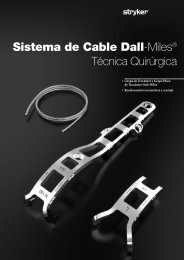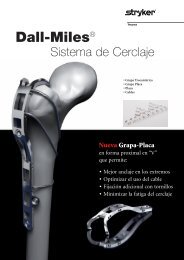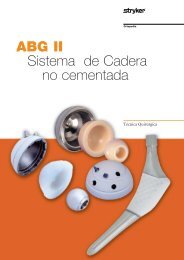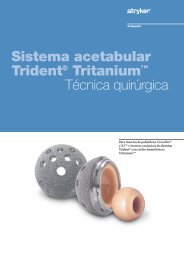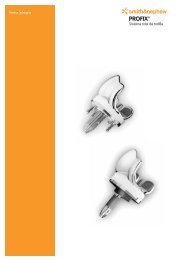Técnica anterógrada - quirofano de Trauma
Técnica anterógrada - quirofano de Trauma
Técnica anterógrada - quirofano de Trauma
Create successful ePaper yourself
Turn your PDF publications into a flip-book with our unique Google optimized e-Paper software.
Características <strong>de</strong>l instrumental<br />
1.2. Características <strong>de</strong>l<br />
instrumental<br />
La principal ventaja incorporada al<br />
instrumental es la integración <strong>de</strong> su<br />
plataforma <strong>de</strong> instrumental, que se<br />
pue<strong>de</strong> utilizar no sólo para el sistema<br />
<strong>de</strong> enclavado femoral T2 completo,<br />
sino que será también la plataforma <strong>de</strong><br />
todos los nuevos sistemas <strong>de</strong> enclavado,<br />
reduciendo <strong>de</strong> este modo complejidad<br />
e inventario.<br />
La plataforma <strong>de</strong>l instrumental ofrece<br />
precisión y maniobrabilidad avanzadas<br />
y presenta guías introductoras<br />
diseñadas ergonómicamente.<br />
A<strong>de</strong>más <strong>de</strong> la precisión y <strong>de</strong> la<br />
maniobrabilidad avanzadas, los<br />
instrumentos están codifi cados<br />
por colores, números y símbolos<br />
para indicar su uso durante el<br />
procedimiento quirúrgico.<br />
El código <strong>de</strong> color y número indica el<br />
paso en el que se utiliza el instrumento<br />
1.3. Referencias<br />
1. Janzing HMJ et al.: The Retrogra<strong>de</strong><br />
Intramedullary Nail: Prospective<br />
Experience in Patients Ol<strong>de</strong>r than<br />
Sixty-fi ve Years. Journal of Orthopaedic<br />
<strong>Trauma</strong> 12 (5) 330-333, 1998<br />
2. Koval KJ et al.: Distal Femoral Nonunion:<br />
Treatment with a Retrogra<strong>de</strong><br />
Inserted Locked Intramedullary Nail,<br />
Journal of Orthopaedic <strong>Trauma</strong>, Vol. 9<br />
N°4, pp. 285-291, 1995<br />
3. Herscovici D Jr. and Whiteman KW:<br />
Retrogra<strong>de</strong> Nailing of the Femur Using<br />
an Intercondylar Approach. Clinical<br />
Orthopaedics and related Research,<br />
332, 98-104, 1996<br />
4. Roy San<strong>de</strong>rs, Kenneth J. Koval et al.:<br />
Retrogra<strong>de</strong> Reamed Femoral Nailing.<br />
Journal of Orthopaedic <strong>Trauma</strong> 1993;<br />
Vol. 7, No. 4: 293-302<br />
durante el procedimiento. Este sistema<br />
<strong>de</strong> codifi cación <strong>de</strong> color está marcado<br />
sobre las ban<strong>de</strong>jas para i<strong>de</strong>ntifi car<br />
rápidamente el instrumento correcto.<br />
6<br />
Paso Color Número<br />
Apertura Rojo 1<br />
Reducción Marrón 2<br />
Introducción <strong>de</strong>l clavo Ver<strong>de</strong> 3<br />
Bloqueo guiado Azul claro 4<br />
Bloqueo a manos libres Azul oscuro 5<br />
El código <strong>de</strong> simbolo indica el tipo <strong>de</strong><br />
procedimiento y no tiene que ver con<br />
el código <strong>de</strong> color.<br />
5. Ostrum F. D., et al., A Prospective<br />
Comparison of Antegra<strong>de</strong> and<br />
Retrogra<strong>de</strong> Intramedullary Nailing,<br />
Friday, October 9, 1998 Session V, 11:31<br />
a. m. OTA Vancouver<br />
6. Ostrum F. D., Joseph DiCicco,<br />
Retrogra<strong>de</strong> In tramedullary Nailing of<br />
Femoral Diaphyseal Fractures, Journal<br />
of orthopaedic <strong>Trauma</strong>, Vol. 12,<br />
N° 7, pp. 464-468, 1998<br />
7. Lucas SE et al.: Intramedullary<br />
Supracondylar Nailing of Femoral<br />
Fractures. A Preliminary Report of<br />
the GSH Supracondylar Nail. Clinical<br />
Orthopaedics and Related Research<br />
296 200-206, 1993<br />
8. T. E. Richardson, M. Voor,<br />
D. Seligson, Fracture Site Compression<br />
and Motion with Three Types of<br />
Intramedullary Fixation of the Femur,<br />
Osteosynthese International (1998), 6:<br />
261-264<br />
Símbolo<br />
Brocas<br />
Rectangular = Intrumentos largos,<br />
Fémur<br />
Triangular = Instrumentos cortos,<br />
Tibia y Húmero<br />
Las brocas se caracterizan por un<br />
anillo codifi cado por color :<br />
4.2mm = Ver<strong>de</strong><br />
Para tornillos completamente roscados<br />
<strong>de</strong> 5,0 mm y para la segunda cortical<br />
cuando se usen tornillos parcialmente<br />
roscados <strong>de</strong> 5,0 mm.<br />
5.0mm = Negro<br />
Para la primera cortical cuando se<br />
usen tornillos parcialmente roscados<br />
<strong>de</strong> 5,0 mm y para ambas corticales<br />
cuando se usen tornillos condíleos.<br />
9. Hutson et al., Mechanical Failures<br />
of Intramedullary Tibial Nails Applied<br />
without Reaming, Clin. Orthop. (1995),<br />
315: 129-137<br />
10. M.E. Muller, et al., Manual of<br />
Internal Fixation, Springer-Verlag,<br />
Berlin, 1991<br />
11. O. Gonschorek, G. O. Hofmann,<br />
V. Bühren, Interlocking Compression<br />
Nailing: a Report on 402 Applications.<br />
Arch. Orthop. <strong>Trauma</strong> Surg (1998), 117:<br />
430-437.<br />
12. Mehdi Mousavi, et al., Pressure<br />
Changes During Reaming with<br />
Different Parameters and Reamer<br />
Designs, Clinical Orthopaedics and<br />
Related Research, Number 373, pp. 295-<br />
303, 2000.




